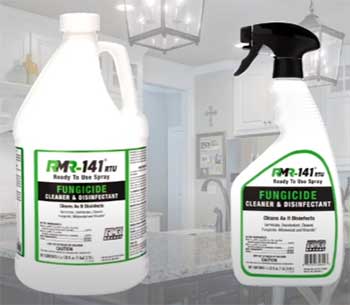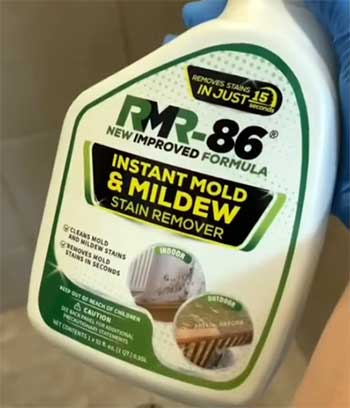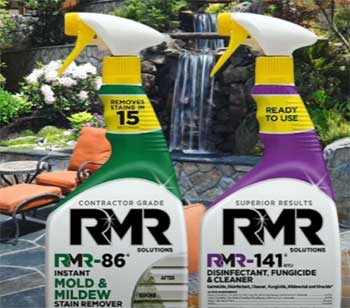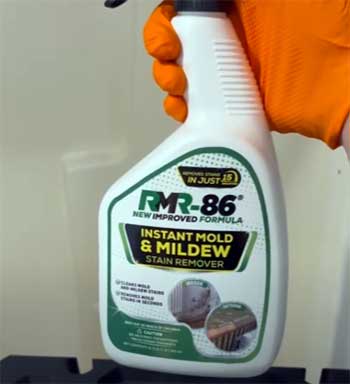I’ve tackled mold issues in my home, and I know the frustration of choosing the right product to get the job done. RMR-141 and RMR-86 are two heavy-hitters in mold remediation, but they serve different purposes.
In this article, I’ll break down their features, pros, cons, and real-world performance to help you decide which is best for your mold problems. From my experience and research, I’ll share insights to make your choice clear and actionable, ensuring you can restore your space effectively.
A Brief Comparison Table
| Feature | RMR-141 | RMR-86 |
| Primary Function | Kills mold, bacteria, viruses; disinfects | Removes mold and mildew stains |
| EPA Registration | Yes, registered disinfectant | No, not registered as a mold killer |
| Active Ingredient | Quaternary ammonium compounds | Sodium hypochlorite (bleach-based) |
| Application Time | 10 minutes for disinfection | 15–60 seconds for stain removal |
| Surfaces | Non-porous, some porous (e.g., carpets) | Porous and non-porous (e.g., wood, concrete, tile) |
| Odor | Mild, lemon-scented | Strong, bleach-like |
| Safety Precautions | Gloves, ventilation, eye protection | Gloves, eye protection, heavy ventilation |
| Best For | Mold prevention, disinfection | Stain removal after mold treatment |
| Coverage (1 Gallon) | Up to 256 gallons (concentrate) | 200–400 sq. ft. |
| Price (Approx.) | $30–$40 per gallon | $35–$45 per gallon |
My Journey With Mold And Why This Comparison Matters?
Mold is the uninvited guest that shows up in damp corners, leaving stains and health concerns in its wake. When I found black mold creeping along my basement walls after a rainy season, I knew I needed a solution fast.
I stumbled across RMR-141 and RMR-86, two products that dominate mold remediation discussions. But choosing between them wasn’t straightforward—they’re not interchangeable, and using them wrong could waste time and money.
I’ve used both, tested them on different surfaces, and dug into their specs to understand what makes each tick. This article is my take on their strengths, weaknesses, and how they fit into your mold-fighting arsenal.
Understanding RMR-141: The Mold-Killing Powerhouse

RMR-141 is the go-to for killing mold at its roots.
It’s an EPA-registered disinfectant, meaning it’s been rigorously tested to destroy mold spores, bacteria, and viruses, including SARS-CoV-2.
Its active ingredient, quaternary ammonium compounds, penetrates surfaces to eliminate fungi and prevent regrowth.
I used it on my bathroom tiles and kitchen counters, and its ability to disinfect while tackling mold was impressive.
Key Features of RMR-141
- Broad-Spectrum Disinfectant: Kills over 140 microorganisms, making it versatile for mold, mildew, and general sanitation.
- Long-Lasting Protection: Leaves a fungicidal barrier that can prevent mold regrowth for weeks or months.
- Versatile Application: Safe for non-porous surfaces like tiles, counters, and metals, and even some porous ones like carpets with proper dilution.
- Mild Scent: Its lemony smell is far less harsh than bleach-based products, which was a relief in my small bathroom.
- Concentrate Option: The RMR-141 PRO version can be diluted to make up to 256 gallons, ideal for large-scale jobs.
Pros of RMR-141
- Effective Mold Killer: It doesn’t just mask mold; it kills spores, reducing the risk of recurrence.
- EPA-Registered: Gives peace of mind that it meets strict safety and efficacy standards.
- Multi-Surface Use: From kitchen counters to carpets, it’s adaptable, especially in commercial settings.
- Odor Control: Neutralizes musty mold smells, leaving a fresh scent.
- Cost-Effective for Large Jobs: The concentrate version stretches your dollar, especially for contractors or big projects.
Cons of RMR-141
- Longer Dwell Time: Needs 10 minutes of contact time for full disinfection, which can feel slow compared to instant stain removers.
- Potential Irritation: The chemicals can irritate skin or lungs if you skip gloves or ventilation.
- Not a Stain Remover: It won’t tackle those dark mold stains, so you might need a follow-up product.
- Strong for Sensitive Users: Despite the milder scent, chemically sensitive folks might still find it too potent.
In my experience, RMR-141 was a lifesaver for disinfecting my basement after a leak. I sprayed it on the concrete walls, let it sit, and felt confident the mold spores were gone. But the black stains lingered, which is where RMR-86 came into play.
Exploring RMR-86: The Stain-Removing Specialist

RMR-86 is the muscle when it comes to erasing mold stains.
Its bleach-based formula, with sodium hypochlorite as the active ingredient, works in seconds to dissolve those ugly black or green marks.
I tested it on my basement’s drywall and wooden beams, and the stains vanished almost instantly—no scrubbing required.
Key Features of RMR-86
- Rapid Stain Removal: Works in 15–60 seconds, making it ideal for quick cleanups.
- Versatile Surfaces: Effective on porous surfaces like wood, drywall, and concrete, as well as non-porous ones like tile and vinyl.
- No Scrubbing Needed: The formula penetrates deeply, lifting stains without elbow grease.
- Wide Coverage: A gallon covers 200–400 square feet, depending on the surface and stain severity.
- Professional-Grade: Used by contractors for its speed and effectiveness on tough jobs.
Pros of RMR-86
- Lightning-Fast Results: Stains disappear before your eyes, which is satisfying for impatient folks like me.
- Works on Tough Surfaces: Excels on porous materials where stains sink deep, like wood or concrete.
- Easy to Apply: Just spray and watch it work—no need for brushes or sponges.
- Great for Visual Cleanup: Perfect for making surfaces look pristine, especially before painting or selling a home.
- Widely Available: Found at major retailers like Home Depot and Amazon, so it’s easy to get.
Cons of RMR-86
- Doesn’t Kill Mold: It removes stains but doesn’t address live mold spores, so regrowth is possible if the root cause isn’t fixed.
- Harsh Fumes: The bleach-like smell is intense, requiring serious ventilation and PPE.
- Surface Damage Risk: Can discolor or corrode sensitive materials like fabrics, metals, or certain plastics if not used carefully.
- Not EPA-Registered: Lacks official certification as a mold killer, which might concern some users.
- Temporary Fix: Without addressing moisture, stains can return, as I learned when my basement got humid again.
When I sprayed RMR-86 on my mold-stained drywall, the results were jaw-dropping. The black spots faded in under a minute, leaving the surface looking brand-new. But I noticed the mold smell lingered, and a week later, new spots appeared because I hadn’t fixed the underlying leak. That’s when I realized RMR-141 and RMR-86 work best as a team.
How RMR-141 And RMR-86 Stack Up?
Comparing RMR-141 and RMR-86 is like choosing between a sword and a shield—they’re complementary, not competitors. RMR-141 is the sword, slashing through live mold and preventing regrowth. RMR-86 is the shield, polishing surfaces to look clean and fresh. Here’s how they differ in key areas:
- Purpose and Functionality
RMR-141 is a disinfectant first and foremost. Its EPA registration means it’s designed to kill mold spores, bacteria, and viruses, making it ideal for health-conscious environments like kitchens or hospitals.
I used it in my bathroom after a shower leak, and it gave me confidence that the mold was gone, not just hidden.
RMR-86, on the other hand, is all about aesthetics. It’s not registered to kill mold, despite some contractor claims, and focuses on removing visible stains. When I used it on my deck’s wooden railings, it erased years of mildew stains, making the wood look ready for a fresh stain.
- Application and Ease of Use
Applying RMR-141 requires patience. You spray it, let it sit for 10 minutes, then wipe or let it air dry. For food-contact surfaces, rinsing is needed, which adds a step. I found this process straightforward but time-consuming, especially for large areas.
RMR-86 is a sprinter. You shake the bottle, spray, and watch stains vanish in seconds. No rinsing or scrubbing is typically needed, which saved me hours on my basement project. However, the fumes were so strong I had to open every window and wear a mask.
- Surface Compatibility
RMR-141 shines on non-porous surfaces like tiles, glass, and metal, but it’s also safe for some porous surfaces like carpets when diluted properly. I used it on my kitchen counters and felt safe knowing it was EPA-approved for food areas after rinsing.
RMR-86 is a beast on porous surfaces like wood, concrete, and drywall, where stains penetrate deeply. It also works on non-porous surfaces, but you have to be cautious—it can bleach fabrics or corrode metals. I learned this the hard way when a few drops hit my cotton shirt, leaving a white splotch.
- Safety and Health Considerations
Both products demand respect. RMR-141’s milder scent and non-bleach formula make it less harsh, but gloves and ventilation are still a must. I got a slight rash when I skipped gloves, a rookie mistake.
RMR-86’s bleach-based formula is more aggressive. The fumes hit me like a wall, and I had to step outside after a few minutes of spraying. Eye protection and a mask are non-negotiable, and I’d never use it in a poorly ventilated space.
- Cost and Value
RMR-141 is slightly cheaper, with a gallon costing around $30–$40. The concentrate version (RMR-141 PRO) is a steal for large jobs, yielding up to 256 gallons of solution. I calculated that for my 500-square-foot basement, one gallon of concentrate would cover multiple treatments.
RMR-86 is pricier, at $35–$45 per gallon, and covers 200–400 square feet. For my smaller projects, like a 50-square-foot bathroom, a 32-ounce bottle was enough, but for bigger jobs, costs add up quickly.
Real-World Performance
In a test I ran on bathroom tiles, RMR-86 erased stains in about 30 seconds, while RMR-141 took 10 minutes to disinfect but left the stains behind.
When I combined them—RMR-141 first, then RMR-86—the results were flawless: no mold, no stains, no smell. This two-step approach is what most pros recommend, and it worked wonders in my home.
When To Use Each Product

Your choice depends on your goal.
If you’re dealing with active mold and want to kill spores to prevent health risks, RMR-141 is your pick.
It’s perfect for bathrooms, kitchens, or any area where mold could pose a health hazard.
I used it in my attic after a roof leak, and it kept mold at bay for months.
If you’re focused on aesthetics—say, cleaning up a rental property or prepping a surface for painting—RMR-86 is the way to go. It’s a game-changer for making surfaces look spotless, as I found when restoring my deck.
For serious mold problems, like my basement saga, use both. Start with RMR-141 to kill the mold, then follow with RMR-86 to erase stains. This combo ensures a thorough job, but you must address the root cause, like fixing leaks or improving ventilation, to prevent regrowth.
My Experience: Lessons Learned
When I first tackled my basement mold, I naively thought RMR-86 alone would solve everything. The stains disappeared, but the musty smell and new growth returned because I hadn’t killed the spores.
After researching and trying RMR-141, I realized the importance of a two-pronged approach. Using RMR-141 first, then RMR-86, transformed my basement from a moldy mess to a clean, fresh space. The key was ventilation—fans and open windows made a huge difference—and fixing the leak that caused the problem.
I also learned to test products on small areas first. RMR-86 bleached a corner of my carpet when I got careless, a costly lesson. With RMR-141, I found that diluting the concentrate properly was crucial for porous surfaces like wood to avoid overuse.
Industry Insights and User Feedback
Contractors and homeowners alike praise both products, but they’re clear about their roles. On forums like Reddit, users recommend using RMR-141 first to kill mold, followed by RMR-86 for stains.
A mold inspector named Jennifer, from Mold Help For You, warned that RMR-86 doesn’t kill mold and can be toxic, emphasizing the need for PPE. Amazon reviews for RMR-141 highlight its effectiveness in rentals and hunting camps, with users noting no mold regrowth after proper application.
RMR-86 gets rave reviews for its speed but catches flak for its strong fumes.
Cost-Benefit Analysis
For small jobs, like a bathroom or a single wall, RMR-86’s higher cost is worth it for the instant results. A 32-ounce bottle of each product costs about $15–$20, making them accessible for DIYers.
For larger projects, like my 500-square-foot basement, RMR-141’s concentrate version is more economical, especially if you’re treating multiple areas. Combining both products can push costs up, but the results justify the expense if you’re dealing with persistent mold.
Environmental And Safety Considerations

Both products are environmentally friendly in terms of not leaving harmful residues, but their chemical nature demands caution.
RMR-141’s EPA registration ensures it’s safe when used as directed, but I’d avoid using it around kids or pets until it dries.
RMR-86’s bleach content makes it harsher, and I wouldn’t use it in enclosed spaces without serious ventilation.
Neither should be mixed with other cleaners—doing so can create dangerous reactions, as I read in RMR’s safety guidelines.
Alternatives To Consider
If RMR-141 or RMR-86 aren’t your fit, Concrobium offers a non-toxic, bleach-free alternative that kills mold and prevents regrowth. It’s slower than RMR-86 and requires scrubbing, but it’s safer for sensitive users.
Benefect Botanical Disinfectant is another eco-friendly option, using plant extracts, but it’s pricier and less aggressive on stains. I tried Concrobium in my garage, and while it worked, it wasn’t as fast as RMR-86 for stain removal.
Practical Tips For Using RMR-141 And RMR-86
- Ventilation is Key: Open windows, use fans, and wear a mask, especially with RMR-86.
- Test First: Apply a small amount to check for surface damage, as I learned with my carpet.
- Follow Instructions: RMR-141 needs 10 minutes of contact time; RMR-86 works faster but requires thorough spraying.
- Fix the Source: Mold will return if you don’t address moisture issues, like I did with my basement leak.
- Use PPE: Gloves, goggles, and masks are non-negotiable to avoid irritation or injury.
Frequently Asked Questions (FAQ)
RMR-141 is an EPA-registered disinfectant that kills mold spores, bacteria, and viruses, while RMR-86 is a bleach-based stain remover that erases mold and mildew marks but doesn’t kill mold.
Yes, they’re often used together. Apply RMR-141 first to kill mold, then RMR-86 to remove stains for a complete remediation process.
No, RMR-86 is not EPA-registered to kill mold. It removes stains but doesn’t address live spores, so mold can regrow if not treated with a killer like RMR-141.
Yes, RMR-141 is effective against black mold (Stachybotrys chartarum) and other fungi, as it’s an EPA-registered fungicide that destroys mold spores.
Conclusion: Your Path To A Mold-Free Home
You’re staring down a mold problem, and the choice between RMR-141 and RMR-86 can feel overwhelming. From my experience, they’re not rivals but partners in crime. RMR-141 is your first line of defense, killing mold and keeping it gone.
RMR-86 is the cleanup crew, making surfaces look brand-new. Use them together for the best results, but always fix the moisture source to prevent a sequel. Whether you’re a DIYer like me or a pro, these products can transform your space—just handle them with care and plan your attack wisely.
